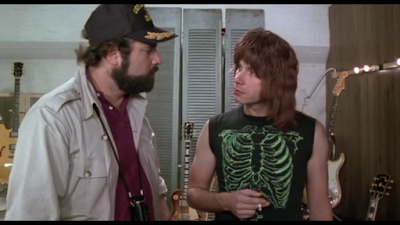 |
| Two towers, old and new. |
The former represents the creative forces of chaos. The latter the ordered forces of law.
It’s a very yin-yang, or Moorcockian, way of looking at things.
The older I get I see the need for both. For tradition, and for change. Both in life, and in art. Perhaps you’ll find this a milquetoast viewpoint, and want more sturm un drang. But not today. I’m feeling reflective.
Defenders of the old see what the masters have done and want that to stand, immobile and fixed, like some mountain. It was great, it still is, why change it?
Proponents of the new see old art and admire some aspects of it, but believe that it no longer reflects present realities. And wish to carve new stone out of the existing material, or make something else alongside it.
I see a lot of angst over this divide, but believe these seemingly opposing forces can be reconciled. Because we need both.
I believe our present culture is entirely too much focused on the new and shiny. And not enough on learning from the brilliant minds who have come before us and did some things better than we do. There is so much to be gleaned from history. Much of what we think of as new has been done before. So don’t confuse looking backwards with a backwards mindset.
But I also recognize change as inevitable, and often results in forward progress. Doing the same thing over and over again results in staleness and conformity. S&S grew moribund in the latter 70s and collapsed in the 80s. The New Wave of SF and its dangerous visions broke away from the hard SF that was itself popular and groundbreaking in the early 20th century, but had become fixed and rigid. And the 60s and 70s saw amazing new works created.
Change is inevitable. It’s always been with us. If you don’t believe so, you might look at H.P. Lovecraft, who broke from the old gothics and ghost stories with his radical new extradimensional horror, or Steven King, who added a blue-collar pop sensibility and more humanity to Lovecraft.
Of course, merely because something is new or subversive doesn’t make it good. Nor does critique of your subversive project mean a bunch of old farts “just can’t handle it.” It just might mean the art was poorly executed. There was a lot of bad old art in the past that was once new, but has been forgotten and discarded. No one remembers most of the authors working in Weird Tales. But those that have lasted have much to teach us.
It’s cool to make new stuff by recombining old things.
It’s OK to love old school stuff, even to repeat or pastiche its forms.
We can have it all. No one is getting hurt by the conservative impulse to preserve, or the liberal urge to subvert.
Where do I fall, preferentially, on this spectrum?
To no one’s surprise I’m a small c conservative when it comes to art. I enjoy some subversive art, and admire the creators who challenge the status quo with potent new visions. Though I find myself preferring subversive material that is old enough to have passed into acceptable territory again. See Elric, or bits of The Once and Future King.
But my deepest sympathies lie with old fiction. Robert E. Howard and J.R.R. Tolkien remain two of my literary lodestars, and always will. I don’t see them as old. I still see them as innovators who broke new ground from old sources, who had their influences but took them and made something wholly original. Powerful enough to spawn imitators, and genres.
In “Beowulf: The Monsters and the Critics,” Tolkien chided the literary critics who sought to study Beowulf by reducing it to its component parts, and in so doing, broke it. Pulled down the old tower turning over stones, not realizing from the top you could see the sea.
But if Tolkien had only looked at and admired the past we wouldn’t have The Lord of the Rings. He also made something new from old legends, and broke new ground, though his own powerful creative impulse.







